Ali H. Jasim1; Kareem A. H. Alghrebawi1*
1, Crop Science Department, Agriculture College, Al-Qasim Green University, Iraq
E-mail:
ajasim11@gmail.com
Received: 26/07/2020
Acceptance: 21/08/2020
Available Online: 22/08/2020
Published: 01/10/2020

Manuscript link
http://dx.doi.org/10.30493/DAS.2020.241168
Abstract
A field experiment was carried out in 2019/2020 growing season in Wasit governorate to study the effect of soil mulching with wheat crop residues (control and mulch), three levels of phosphorus (0, 120 and 240 kg ha-1) and four concentrations of humic acid (0, 1000, 2000, and 3000 mg l-1) and their interaction on vegetative growth and green pods yield of broad beans. Split-split plots arrangement within a randomized complete block design with three replications was used. The experimental unit was 6 m2 with a length of 2 m and a width of 3 m. The seeds of broad bean (Semillas Fito variety) were seeded in hills 25 cm apart on lines 50 cm apart, on October 5, 2019. The results showed that soil mulch and the addition of the phosphorus level (240 kg ha-1) led to a significant increase in all characteristics studied (plant height, number of leaves, leaf area, leaf area index, number of branches, pod weight, and green pods yield) compared to the control treatment. Humic acid spraying at 2000 mg l-1 caused a significant increase in plant height, leaf area, and leaf area index. The interaction between the factors also caused a significant increase in leaf area, leaf area index, plant branches number, pod weight, and green pods yield to 2108 cm2, 1.687, 11,300, 17.99 g, and 15.13 t ha-1, respectively, compared to the control treatment.
Keywords: Soil mulch, Phosphorous, Humic acid, Broad bean
Introduction
Vicia faba L. (Broad bean / Faba bean) is one of the important winter crops in the global food production system since it is characterized by its nutritional importance and high protein content (approximately 20-36%) as well as its carbohydrates content (48-54%), minerals, and vitamins [1][2]. Broad bean is one of the highly consumed crops in its production season since its green pods and soft or dry seeds can be used [3].
Covering the soil with crop residues is one of the processes of improving the plant’s environment, maintaining soil moisture, regulating its temperature, reducing salinity, increasing the proportion of its organic matter, and reducing the competition induced by weeds [4]. The good growth of the crop is related to the availability of important nutrients. Phosphorus is one of the essential nutrients for plant nutrition and it plays an important role in the physiological processes and enzymatic reactions of the plant. [5][6] concluded that phosphate fertilizing at levels 40 and 80 kg h-1 led to an increase in the vegetative growth of broad beans and improved yield quantity and quality. Humic acid is one of the organic acids that are produced naturally from humic substances and its composition contains nitrogen, oxygen, and hydrogen in varying proportions, which produces compounds of different molecular weights. These substances are characterized by their rapid effectiveness in improving the nutritional status of the plant, accelerating growth, and increasing yield. [7][8] found that spraying humic acid at a concentration of 2 g m-1 induced a significant increase in the indicators of vegetative growth of broad beans, including plant height, number of leaves, branches, and leafy area. Given the importance mentioned above, a field trial was conducted to study the effect of soil cover, phosphorus fertilization, and humic acid on broad beans growth and yield indices.
Materials and methods
An experiment was conducted in Wasit Governorate during the winter season of 2019/2020 in sandy loam soil (table 1) to study the effect of soil mulching with wheat residues (control and mulching), three levels of phosphorus (control, 120 and 240 kg ha-1 P2O5) (P0, P1, and P2 respectively) and four concentration of humic acid (control, 1000, 2000 and 3000 mg L-1) (H0, H1, H2, and H3 respectively). Split-split plot arrangement within a randomized complete block design (RCBD) with three replications was used. Broad bean seeds (var. Semillas Fito) were sown on 5 October 2019 in hills 25 cm apart. The experimental unit contained 4 lines 50 cm apart and 3 m long (6 m2). Soil chemical and physical properties can be seen in (Table 1). The phosphate fertilizer was added at planting inline 10 cm from the seed line, while the nitrogen fertilizer (40 Kg ha-1) was added after 40 days from planting.

Ten plants from internal ridges were inspected randomly from each experimental unit. Plant height (cm) was measured as the mean of these ten plants at maturity from earth to plant top. Leaves number per plant was calculated as the mean for these ten plants. Leaf area index was measured by choosing ten fully expanded leaves and measuring its area using leaf area meter and the leaf area index was then calculated as follows:
Leaf area index (LAI) = [Plant leaves number x Average leaf area (cm2)] ÷ The area occupied by the plant (cm2)
The area occupied by the plant (cm2) = 10000 ÷ Average number of plants per m2
The number of branches per plant was reported as means of the branches in the ten chosen plants. Green pod weight (g) was measured at green pod maturity, 20 randomly chosen pods from each experimental unit were weighted, and mean was calculated. Green pod yield was reported as the yield of green pods from plants in two ridges of each experimental unit and attributed to the hectare. The data were collected, analyzed and the means were compared using the least significant difference (LSD) test at a probability level of 0.05.
Results and Discussion
Plant height (cm)
Soil mulch, phosphorus and humic acid applications had a significant effect on plant height, Soil mulch with wheat residues significantly increased the plant height to (112.56 cm) compared to the control treatment (97.18 cm). On the other hand, phosphorus level of 240 kg ha-1 gave the highest average plant height (107.40 cm), compared to control treatment (101.27 cm) which was similar to [9] who found that phosphorus application increased broad bean plant height. Humic acid concentrations at 3000 mg l-1 gave the highest average plant height (106.97 cm), compared to control treatment (101.03 cm). This result is similar to [10] who found that plant height was improved by increasing the levels of humic acid application. The interaction between soil mulch and phosphorus adding had a significant effect on plant height and soil mulch with 240 kg ha-1 phosphorus application achieved the highest average (113.85 cm) compared to control treatment (93.14 cm) (Table 2).
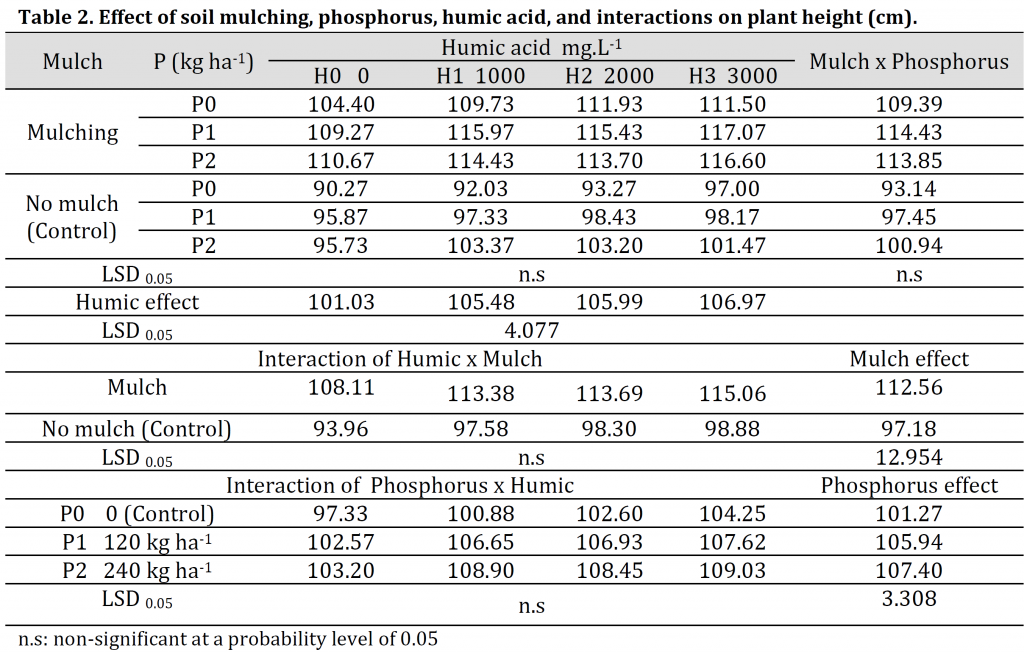
Number of leaves per plant
Soil mulching and phosphorus levels had significant effects on the number of leaves per plant. Soil mulch with wheat residues had a significant effect in increasing plant leaves number to 62.86 compared to control treatment (46.71). Phosphate fertilizer at 240 kg ha-1 gave the highest leaves number (57.38) compared to the control treatment (52.13). This was consistent with [10] who reported that phosphorus application induced an increase in the number of leaves per plant. Humic acid spray concentration had no significant effect on this trait. The interaction between soil mulch and phosphorus adding had a significant effect and soil mulch with 240 kg ha-1 phosphorus achieved the highest average (64.43) compared to control treatment (43.92) (Table 3)
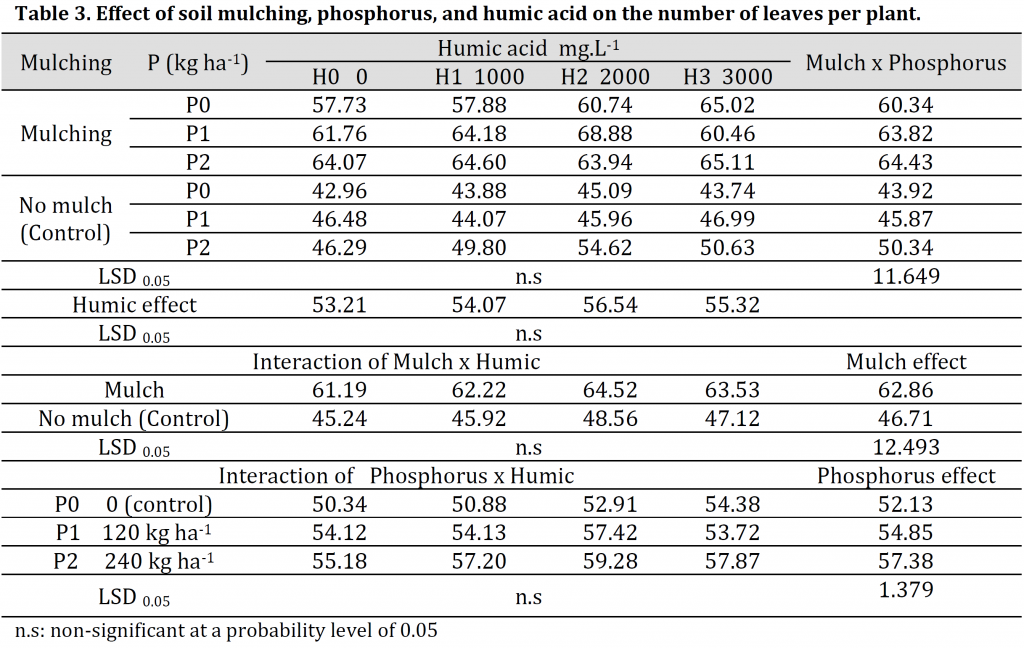
Leaf area index
Soil mulch achieved the highest leaf area value of 1.546 compared to control treatment (0.997). This is consistent with [11] who found that soil mulch positively contributed to the leaf area index of green beans. Additionally, phosphorus level of 240 kg ha-1 gave the highest value (1.341), compared to control treatment (1.175) (Table 4). Humic acid at 2000 mg l-1 wasachieved (1.337) compared to control treatment (1.197). The interaction between the factors had a significant effect, and soil mulch with120 kg ha-1 phosphorus and 2000 mg l-1 humic acid achieved the highest value (1.687) compared to control treatment (0.873).
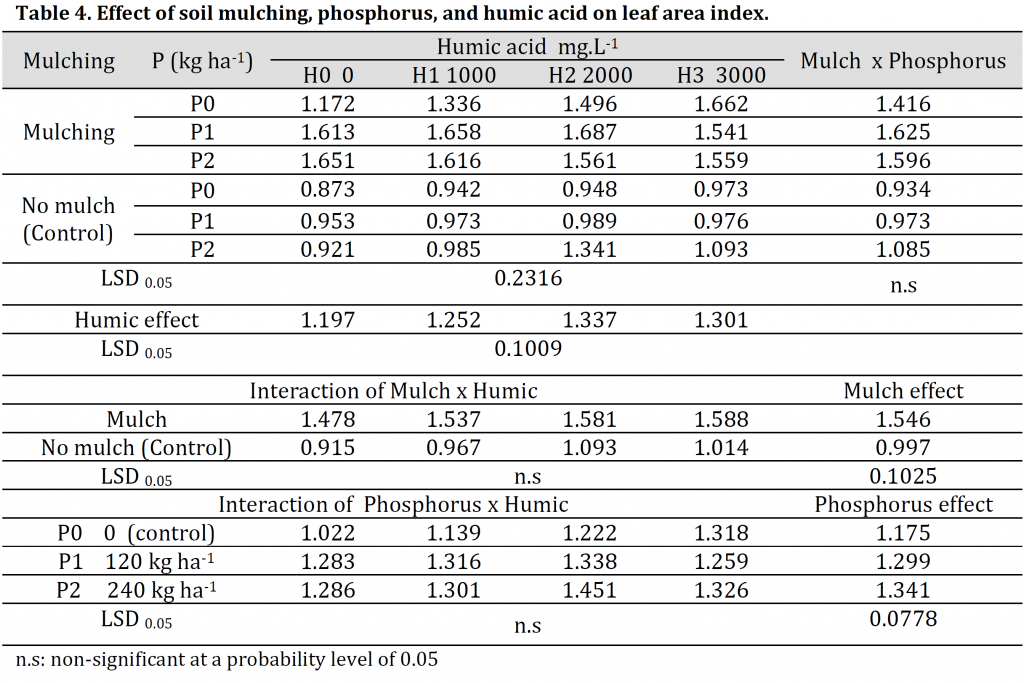
Number of branches per plant
Soil mulch with wheat residues significantly increased the number of branches to 8,595 branches per plant compared to control treatment (6,637). This is consistent with [12] who found that soil mulch increased okra plant branches. Phosphorus levels significantly affected plant branches number, and the level of 240 kg ha-1 achieved the highest number (8.323), while control treatment gave the lowest number (6.963). This result was in line with [13][14] who found that phosphorus fertilizer increased the number of branches per plant. The interaction between mulching and phosphorus caused a significant effect, and mulching along with 240 kg ha-1 phosphorus application resulted in the highest branches number (10.033) compared to control (6.549). Additionally, the interaction between the three factors caused a significant effect, and soil mulch with 240 kg ha-1 phosphorus and 2000 mg l-1 humic acid achieved the highest number (11.300) compared to control treatment (6.644) (Table 5).
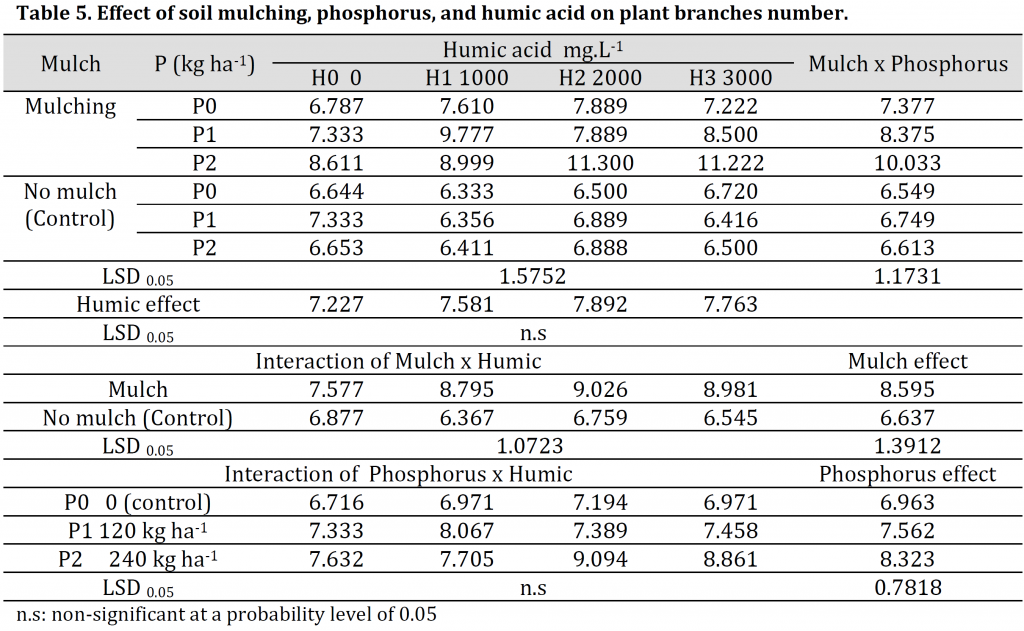
Green pod weight (g)
As can be seen in (Table 6), soil mulch, phosphorus levels, and humic acid concentration had no significant effect on green pod weight, while the interaction between phosphorus levels and humic acid concentrations caused a significant effect, and 120 kg ha-1 phosphorus with 1000 mg l-1 humic acid application gave the highest weight (16.88 g) compared to control treatment (12.52 g). The interaction between the three factors caused a significant effect, and soil mulch with 240 kg l-1 phosphorus and 1000 mg l-1 humic acid gave the highest pod weight of 17.99 g.
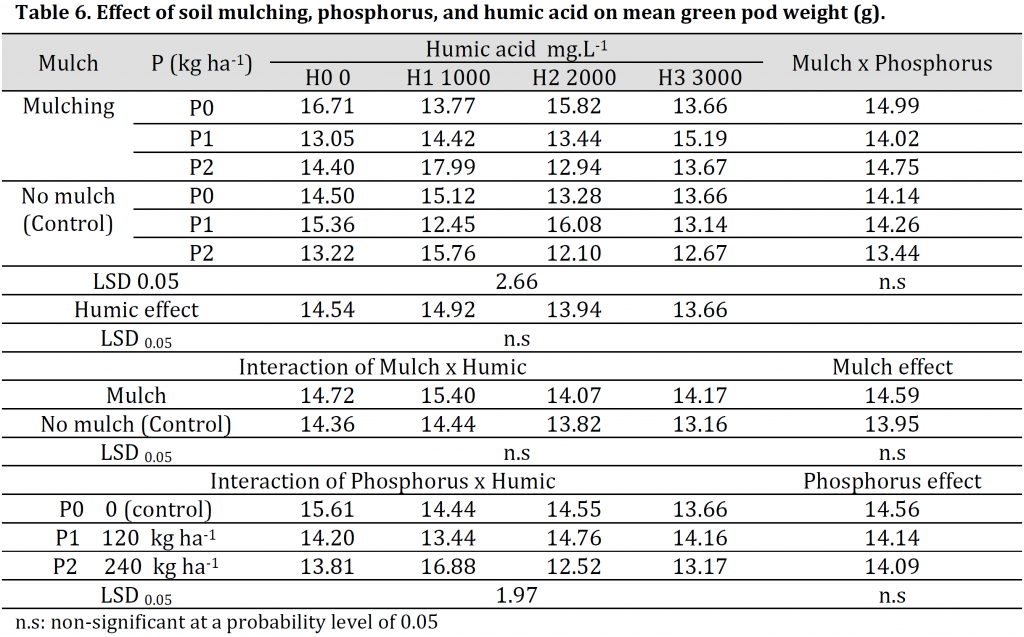
Green pod yield (ton/ha)
Soil mulch, levels of phosphorus, and concentrations of humic acid had induced significant effects on green pods yield (Table 7). Soil mulching with wheat waste residue caused a significant increase in green pods to yield to 13.44 tons ha-1 compared to control treatment (10.61 tons ha-1). This result was in line with [11] who found that organic and inorganic mulch caused an increase of green bean yield. Phosphorus levels also had a significant effect, and both 120 and 240 kg ha-1 treatments resulted in the highest yield with 12.35 and 12.39 tons ha-1, respectively compared to control treatment (11.32 tons ha-1). This result was in line with [13][14] who found that phosphorus fertilizer application increased broad bean yield. Humic acid spraying significantly increased pod yield, and the highest average yield was observed under 1000 mg l-1 humic acid application with 12.59 tons ha-1, while control treatment gave the lowest yield (11.61 tons ha-1). These results were in correspondence with [15][16] who found that humic acid spraying had significantly increased faba bean yield. The interaction between phosphorus and humic had a significant effect on pods yield and 120 kg ha-1 phosphorus with 2000 mg l-1 humic acid and 240 kg ha-1 phosphorus with 1000 mg l-1 humic acid had the highest pods yield with 13.58 and 13.85 tons ha-1, respectively compared to control (10.52 tons ha-1). Additionally, the combined effect of soil mulch with 120 kg ha-1 phosphorus and 1000 mg l-1 humic acid gave the highest green pods yield (15.13 tons ha-1) compared to control (9.67 tons ha-1).
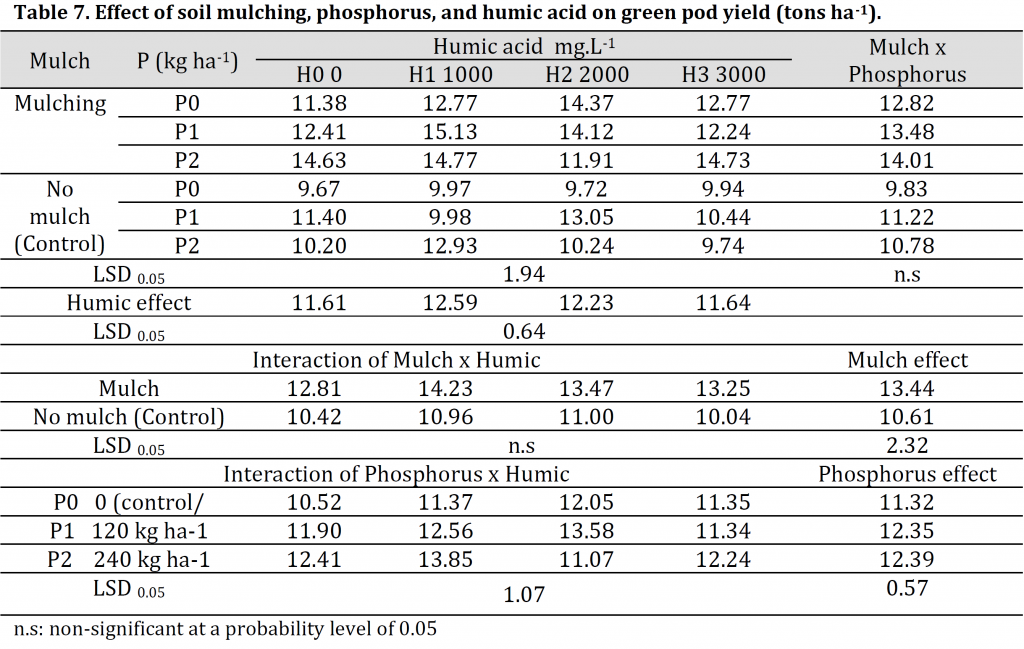
The significant increase achieved in all characteristics of vegetative growth as a result of soil mulch with wheat residues is due to the effect mulch in regulating soil temperature and retaining moisture [17] which reflected positively on improving root growth and increasing plant height [18]. Phosphorus plays a vital role in plant growth due to its direct effects on apical growth in addition to cell division and elongation [19]. These positive effects of phosphorus were observed in the current study which corresponded with [20][21] who indicated that adding phosphate fertilizers in balanced quantities had led to an increase in photosynthesis products accumulation and transportation which reflected positively on increasing plant leaf area and its index. The results shown in tables (2, 4 and 6) indicate a significant increase in vegetative growth and yield under humic acid application, and this is due to its important role in nutrient absorption and in increasing the effectiveness of cellular enzymatic system [22] and hormones [23][24] that induce an increase in plant growth characteristics such as plant height, leaf area index, and green pods yield [24][25][26].
Conclusions
The results of the experiment showed that the use of wheat residue coverage in addition to phosphorus fertilization, and humic acid application reflected positively on the characteristics of vegetative growth and increase the green pods yield of broad bean. The combined effect of mulching, 240 kg.h-1 phosphorus fertilization, and 2000-3000 mg l-1 humic acid application achieved a significant increase in all the characteristics of vegetative growth. Other tracks and studies may be required to investigate the full potentials for the factors of this experiment under different environmental conditions.
References
| 1 | Akinci S, Bueyuekkeskin T, Eroglu A, Erdogan BE. The effect of humic acid on nutrient composition in broad bean (Vicia faba L.) roots. Not. Sci. Biol. 2009;1(1):81-7. DOI |
| 2 | Gutierrez N, Avila CM, Moreno MT, Torres AM. Development of SCAR markers linked to zt-2, one of the genes controlling absence of tannins in faba bean. Aust. J. Agric. Res. 2008;59(1):62-8. DOI |
| 3 | Ofuya ZM, Akhidue V. The role of pulses in human nutrition: a review. J. Appl. Sci. Environ. Mgt. 2005;9(3):99-104. |
| 4 | Chalker-Scott L. Impact of mulches on landscape plants and the environment—a review. J. Environ. Hort. 2007;25(4):239-49. DOI |
| 5 | Jat RS, Ahlawat IP. Direct and residual effect of vermicompost, biofertilizers and phosphorus on soil nutrient dynamics and productivity of chickpea-fodder maize sequence. J Sustain Agr. 2006;28(1):41-54. DOI |
| 6 | Adak MS, Kibritci M. Effect of nitrogen and phosphorus levels on nodulation and yield components in faba bean (Vicia faba L.). Legum. Res. 2016;39(6):991-4. DOI |
| 7 | El-Habbasha SF, Ahmed AG, Mohamed MH. Response of some chickpea varieties to compound foliar fertilizer under sandy soil conditions. J. Appl. Sci. Res. 2012;8(10):5177-83. |
| 8 | Knany RE, Atia RH, El-Saady AS. Response of faba bean to foliar spraying with humic substances and micronutrients. Alex. Sci. exch. j. 2009;30(4):453-60. DOI |
| 9 | Alemayehu D, Shumi D. Response of faba bean (Vicia faba L.) to phosphorus nutrient application in Bore Highlands, Guji Zone, Southern Ethiopia. Agric. Res. Tech. 2018;17(4):107-14. |
| 10 | El-Bassiony AM, Fawzy ZF, Abd El-Baky MM, Mahmoud AR. Response of snap bean plants to mineral fertilizers and humic acid application. Res. J. Agric. Biol. Sci. 2010;6(2):169-75. |
| 11 | Kwambe XM, Masarirambi MT, Wahome PK, Oseni TO. The effects of organic and inorganic mulches on growth and yield of green bean (Phaseolus vulgaris L.) in a semi-arid environment. Agric. Biol. J N. Am. 2015;6(3):81-9. |
| 12 | Gordon GG, Foshee WG, Reed ST, Brown JE, Vinson EL. The effects of colored plastic mulches and row covers on the growth and yield of okra. Amer. Soc. Hort. Sci. 2010;20(1):224-33. DOI |
| 13 | Yasmin W, Paul SK, Anwar MP. Growth, yield and quality of faba bean (Vicia faba L.) in response to sowing date and phosphorus fertilization. Arch. Agric. Environ. Sci. 2020;5(1):11-7. DOI |
| 14 | Tekle EK, Raghavaiah CV, Arvind C, Hamza I. Effect of faba bean (Vicia faba L.) genotypes, plant densities and phosphorus on productivity, nutrients uptake, soil fertility changes and economics in Central highlands of Ethiopia. Int. J. Life Sci. 2015;3:287-305. |
| 15 | El-Kholy AS, Aly RM, El-Bana AY, Yasin MA. Yield of faba bean (Vicia faba L.) as influenced by planting density, humic acid rate and phosohorus fertilization level under drip irrigation system in sandy soils. Zagazig J. Agric. Res., 2019; 46 (6A): 1-12. DOI |
| 16 | Bayoumi MA, Selim TA. Effect of nitrogen, humic acid and bio-fertilization on productivity and quality of faba bean under saline condition. J. Soil Sci. and Agric. Eng. 2012 Aug 1;3(8):829-43. DOI |
| 17 | Nair A, Havlovic BJ. Mulch and row cover affect lettuce production in high tunnels. Iowa State University Research and Demonstration Farms Progress Reports. 2013(3). |
| 18 | Hobbs PR, Sayre K, Gupta R. The role of conservation agriculture in sustainable agriculture. Phil. Trans. R. Soc. B. 2008;363(1491):543-55. DOI |
| 19 | Somayeh GN, Hashem A. Effects of phosphorus fertilization and pseudomonas fluorescens strain on the growth and yield of faba bean (Vicia faba L.). Idesia (Chile) 2013;33(4):15-21. DOI |
| 20 | Ahmed MA, El-Abagy HM. Effect of bio-and mineral phosphorus fertilizer on the growth, productivity and nutritional value of some faba bean (Vicia faba L.) cultivars in newly cultivated land. J. of Appl. Sci. Res. 2007;3(6):408-20. |
| 21 | Jasim AH, Rashid HM, Ghani MM. Effect of foliar nutrition of phosphorous and potassium on vegetative growth characteristics and yield of broad bean. Euphrates J. Agric. Sci., 2016; 8 (3): 50-5. |
| 22 | Saadati J, Baghi M. Evaluation of the effect of various amounts of Humic acid on yield, yield components and protein of chickpea cultivars (Cicer arietinum L.). Int. J. Adv. Biol. Biom. Res. 2014;2(7):2306-13. |
| 23 | Jasim AH, Al-Dulaime KL. Effect of adding some organic fertilizers on some nutrients and hormones content of faba bean (Vicia faba L.) leaves. 2nd Scientific Conference, College of Science, Karbala University, Iraq. 2014:93-9. |
| 24 | Selim EM, Mosa AA, El-Ghamry AM. Evaluation of humic substances fertigation through surface and subsurface drip irrigation systems on potato grown under Egyptian sandy soil conditions. Agric. Water Manag. 2009;96(8):1218-22. DOI |
| 25 | Jasim AH, Mohsen NA. Effect of seeding times, foliar treatments (with salicylic acid, humic acid and high phosphorous fertilizer) and their interaction on mung bean yield. IOSR J. Agric. And Vet, Sci. 2014;7(12):8-11. |
| 26 | Jasim AH, Hadi KF. Effect of silicon, GA3 and humic acid on green pods yield of broad bean. Euphrates J. Agri. Sci., 2017;9(4):117-30. |
Cite this article:
Jasim, A., Alghrebawi, K. Effect of soil mulch, phosphorus levels and humic acid spray on the growth and green pods yield of broad bean. DYSONA – Applied Science, 2020;1(3): 88-95. doi: 10.30493/das.2020.241168
